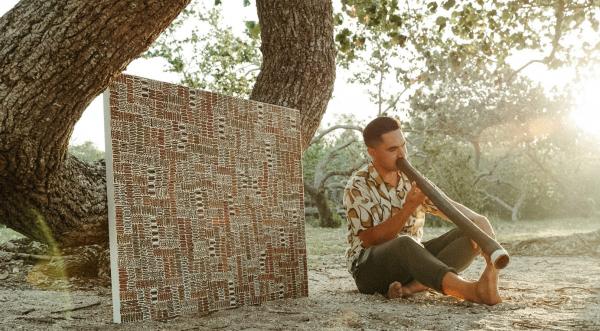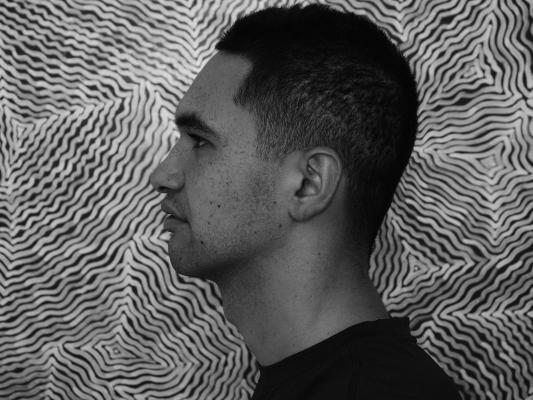By Ian Pugh
Ethan-james Kotiau felt a flutter of nerves as he looked out across the packed auditorium. It was a big occasion – an exhibition at Brisbane’s prestigious Aurecon Building to raise money for the victims of the 2019-20 bushfires. The event had sold out and there were a lot of high-profile people there. It was the first time his art had ever been shown to a large audience – and now one of his paintings was about to go under the hammer. It had already been an incredible journey. Where would it take him next? As the auctioneer stepped up to the podium and unveiled his painting, he knew he was about to find out …
It had only been a year since his journey as an artist had begun, and yet so much had happened already. To think that one short year ago he had been working as a pest technician, helping to install termite prevention systems with Cooroy Termite & Pest Control. It was not a time he regretted at all. He had met a lot of good people and the work had helped him support his two sisters and pay the bills. But inside, there was something burning which he was finding impossible to ignore. He could only describe it as “a creative fire” and it was burning him up from the inside. He knew he had to deal with it, but he wasn’t sure how.
Music was his first thought. With a longstanding passion for making music, he was already collaborating with musician friends in Brisbane. He ended up moving to the city where he worked hard to try and make inroads into the music industry. It was tough going and there were still bills to be paid. Before long, he found himself working as a cook in a hospital kitchen. But the creative fire raged on. “I felt like I was going mad,” he remembers. “I was getting depressed. I knew I had to do something. I just wasn’t sure what.”
It was around this time that he found himself inside an art gallery, standing in front of a huge painting – a massive statement piece by Ningura Napurrula Gibson. As a member of the Gunggarri people (through his mother), he was used to being around Aboriginal art and culture. He had had a close relationship with his grandmother while growing up on Iningai country in the Longreach area and she had taught him a lot about their land and culture. But none of this could have prepared him for the impact Ningura’s painting had on him that day. “Looking at this piece, I couldn’t understand why it was making me feel so emotional,” he remembers. “It touched my heart. It was like I could feel the soul of it. I felt like crying.” When the gallery director came over and explained more about the painting – that it was about women’s business – he was reminded of his grandmother’s stories and his connection with the piece grew even stronger. “It was like seeing a piece of me in the mirror that I hadn’t seen before,” he says. “That’s when I decided I wanted to paint.”
He never went back to his job. Instead, he bought canvasses and started to paint. Looking back, he admits that some of the decisions he made during this period were not the most responsible. It was not an easy path he had chosen – far from it. Without a job, he could no longer afford the rent so he decided to live in his van. “I set up my van and started painting out of it,” he says. “I didn’t want to tell my family, so they didn’t know.”
Things got tougher. Some days he didn’t have much to eat and was forced to take advantage of free coffees from a 7-Eleven promotion. But he was painting and he still felt confident that he was doing the right thing. It was often prayer that gave him the strength to keep going. “I learnt not to be anxious about the next day. Just do what you can today. I learnt to be happy without having much. To appreciate what I did have.”
The next challenge was how to sell his work. At one stage he tried going door-to-door. It was a daunting experience – a few days of people saying no and doors being closed in his face. Then a friend suggested that he try and sell through Facebook marketplace. He put some paintings up but had no idea how to price his work. Not a lot was happening until he received a message – some guy asking if he had ever exhibited his work before. He decided to be totally honest. “I told him I’d only been painting for a few months and that I’d never exhibited anything before.” Ethan would never forget the reply he received. “He asked if I wanted to come and meet him at his gallery.”
It was an opportunity he knew he couldn’t miss, even though he had only just enough money for a train ticket. (“I had been saving it for a $5 pizza”). He thought about jumping on the train illegally but then remembered that “you reap what you sow”. He bought the ticket and went and met the gallery owner. “The first thing he said to me was that your paintings are amazing but you are selling them for way too cheap!”
It was the start of a new chapter. The gallery owner helped Ethan exhibit his work in a group exhibition. He also gave him a lot of good advice and introduced him to people in the art world. One thing led to another until he found himself at the art auction in the Aurecon Building.
Ethan remembers the night clearly. His painting was one of the last to be auctioned. “I didn’t know what to expect,” he says. “When the hands started going up, I couldn’t believe it. The price was jumping up in $50 increments. At the end, the crowd erupted. It sold for over $1,000 – one of the highest prices for a painting that night.”
It was a turning point. Doors began to open and he started to meet the right people. He was also commissioned to do a painting which turned out to be a very important piece. For inspiration, he had decided to “take it back home”, back to Iningia, his traditional country. “The painting came out of respect for the place,” he explains. “It was a way to preserve and shed light on the beauty of the country.” The people who had commissioned the painting “were completely blown away by it.” It became the first in a series and marked the beginning of what has now become his signature style.
Soon, he was earning enough to rent a place. The one thing he had missed while living in his van was a bathroom. “When I ran the hot water for the first time I cried,” he remembers. “I slept on the carpet that night but I was home and I was happy.” He thanked his God and made a promise to always be grateful and to always “give back”.
A few years have passed since then and Ethan is now happily married and working towards his first solo exhibition. He sells his work through his website (www.landrivercreeks.com), as well as in galleries such as Ninbella (www.ninbella.com). He also spends a few days each week on his Christian Ministry work. He is grateful for the gift he has been given and remains determined to give back in any way he can. He is using his art to educate people about aspects of Aboriginal culture and the land. He also wants to use his own story to show others what is possible. He believes that everyone can overcome challenges if they “open their hearts” and focus on giving rather than receiving. “Anything is possible when you put love into it,” he says. He’s ready for the next journey and we can’t wait to see where it leads.







